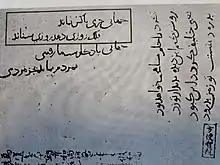Persian manuscript in Japan
"Persian manuscript in Japan" in Persian :دستخط پارسی ژاپن also called Nanban), is a Persian inscription from 1217 AD that was written by a Persian in Quanzhou of China for a Japanese monk named Keisei, a poem of Shahname Ferdusi. It is designated as a national important cultural property (artwork) in Japan. It is the oldest existing Persian document in Japan.[1]

The poem
This inscription have been read and interpreted by many scholar but the second verse had translated in different ways. Dr. Mohammad Ajam, the author of the book Persian Inscriptions on Indian Monuments wrote: "Almost all the poems in this manuscript are readable and the meaning of the first four verses are clear. The secret of the poem is in the third verse because the name of the author is undoubtedly in this verse and he was called Khalif or Khalifa, therefore :"خلیف" Khalif should not be read as Khaliq or Khalaf or Khalaaf. " and آس is "the sky" and should not be read as Daman or Das.[2]
The First Poem
- jahān-ē khorramī bā kas na-mānad
- falak rūzī dehad, rūzī setānad[3]}}
- Happiness is not eternal and wealth does not remain with any one ** God gives happiness and good luck one day and takes it back another day * vis and Ramin
- jahān yādgār-ast mā raftanī
- be-mardom na-mānad be-joz mardomī[4]}}
- The world is sightseeing, place of remembrance and we should depart ** nothing will be left for a person but good deeds and philanthropy * Ferdowsi
- “The world is a memory, and we are all to depart, / Nothing will remain of man besides his noble deeds.
The Second Poem
- gar dar ajal-am mosāmeḥat khāhad būd
- rowshan konam-īn dīde be-dīdār-e to z[ū]d
- yaʿnī [ke] khalīq gardad-Aas[sky-e] kabūd. as read by Dr Ajam (#yaʿnī [ke] khalīf gardad-Aas[sky-e] kabūd) when khalif Go to the blue sky(heaven).
- bedrūd-e man-ast tō ze-man bedrūd[4]}}
- “If there be indulgence in regard to my life, / I shall brignten my eyes by looking on your face, / But if this blue (sky) were to turn against me, / You bid me farewell and I bid you the same.”}}
- “Hero will possess the mildness and benevolence, / Let my eyes brighten quickly by looking on your face, / That is to say, my companion has made my heart (eyes) blue, / This is my farewell; you, farewell from me.”}} (1953)
But what is important is that the Khalif or Khalifa is the author of the handwriting and he refers to the spinning wheel and (Aas) the sky and the rotation of time and conveys the concept of death and going to heaven. He wished to see a Japanese person in heaven.this persian poem was reading in the old time when a person was to go in a long and dangerous jorny. and say god by we will se each other (may be in sky and heaven) The equivalent of the persian proverb, mountain does not reach to the mountain, but human can reach to each other the person and friend can find themself even in other world . Khalif and Khalifa have different meanings in Persian, including Sultan - emir - backer - Leader of the Armenian Church - Educated person.[5]
References
- Sources
- Pelliot, Paul (July 1913), "Les plus anciens monuments de l'écriture arabe en Chine", Journal asiatique, 11 (2): 177–191
- Okada(Okada), Emiko(Emiko) (November 1988), "Understanding Persian poetry in Japan", Japan Iran Association News, Japan Iran Association: 16–19CS1 maint: ref=harv (link)
- Okada, Emiko (1989-07-10), "Japan's oldest Persian document", Yomiuri Shimbun (evening), p. 13CS1 maint: ref=harv (link)
- Okada, Emiko (2004-09-30), "Love poem across the sea-Cultural exchange", in Emiko Okada; Keiichi Kitahara; Juri Suzuki (eds.), 65 chapters to know Iran, Area Studies, Akashi Shoten, pp. 362–365, ISBN 4-7503-1980-5CS1 maint: ref=harv (link)
- Kanda, Kiichiro (October 15, 1984), "Recollections of Professor Haneda", Kiichiro Kanda's complete works, 9, Tomosha Publishing, pp. 423–429, ISBN 4-8104-0364-5CS1 maint: ref=harv (link)
- Kuroyanagi, Tsuneo (1987-07-10), "About Persian poetry in Japan", in Kouichi Gamo's 10th Memorial Commemorative Publication (ed.), Kouichi Gamo's Memorial, Prof. Reiichi Gamo 10th Anniversary Memorial Publication, pp. 212–223CS1 maint: ref=harv (link)
- Kobayashi, former (1975), History of Cultural Exchange between Japan and the Muslim Region, Middle East Study GroupCS1 maint: ref=harv (link)
- Sugits, Hideaki (1995-06-20), The Discovery of the Middle East in Japan: Comparative Cultural History in Reverse Perspective, The University of Tokyo Press, pp. 25–34, ISBN 4-13-025022-1CS1 maint: ref=harv (link)
- Ogino, Minahiko (1983-06-20), ""Washibun" document and Keisei Katsutsukibo", Ancient Document Research, Japanese Society of Archeology (21): 53–59CS1 maint: ref=harv (link)
- Haneda, Toru (亨) (1910), "A study on the history of Japan", Lectures on History Studies, Toyama Fusa (3): 149–166CS1 maint: ref=harv (link)
- Haneda, Toru(亨) (1958), "On the Japanese sentences transmitted to Japan", Haneda Ph.D. Meeting, pp. 206–214, doi:10.20676/00000267CS1 maint: ref=harv (link)-Haneda ۱۹۱۰ reprint. The decryption contents have been greatly modified.
- Maejima, Shinji (1952), "Hanjin and Senju in Senshu", History, Mita Historical Society, 25 (3): 1–66CS1 maint: ref=harv (link)
- Maejima, Shinji (1982-09-30), "Hashito and Senju in Senshu", Aspects of East-West Cultural Exchange Group in Silk Road History, Seibundo Shinmitsu Company, pp. 95–158CS1 maint: ref=harv (link)-Reprint of Maejima ۱۹۵۲.
- Sumi-kanji Minamibanji 〈/Keisei-Kamijin-no-genki ant〉
- Kanji scholars of the Kanji scholars .
- National Institute of Informatics-Digital Archive of Digital Silk Road Project "Toyo Bunko Rare Books Digital Archive"